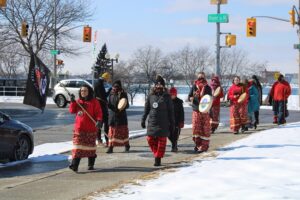No More Stolen Sisters flag was raised on Sarnia’s waterfront

By Colin Graf
SARNIA— People walking through downtown Sarnia on Valentine’s Day weekend turned their heads to see tokens of love, tinged with sadness, hanging outside of City Hall. Red dresses, symbolic of Canada’s Missing and Murdered Indigenous Women and Girls, were displayed as reminders of violence against Indigenous women, both in the past and present.
The dresses were hung to represent “the spirits of our sisters who were taken from us in a violent way,” said Deborah Munroe, executive director of the Sarnia-Lambton Native Friendship Centre, to a small crowd as the No More Stolen Sisters flag was raised at a waterfront park along the St. Clair River.
A short march with drumming and singing carried the people marking the day to City Hall to see the dresses and hear remarks from Munroe and others.
“For us, this march symbolizes strength, power, unity, and an opportunity for healing,” she said.
The problem of violence against First Nations women is not just something that has been dealt with by the MMIWG commission, Munroe says. In fact, she says figures from Statistics Canada from 2012-2018 show 27 percent of missing or murdered Canadian women were Indigenous, although they only make up five per cent of the population. Indigenous women face seven times more violence than other Canadian women today, she adds.
“It (violence) happens everywhere. We have had local women who have been victims of violence. It’s not just an issue out west,” Munroe explained.
There isn’t enough awareness in southwestern Ontario of the dangers faced by First Nations women and girls, says Heather MacDonald, coordinator of the Akwe:go childrens’ program at the Friendship Centre, who sang during the march. The issue became very close to her after a child she knew in Toronto went missing.
“Women are trafficked all across the country,” MacDonald says.
The Sarnia Friendship Centre helps women and girls with programs to promote community wellness, healthy lifestyles and healthy relationships, says director Munroe. Specially organized Sharing Circles were to be held in February to help families grieving the loss of members to violence, she added.
The red dress display and flag-raising ceremony were conducted in partnership with the city government. Councillor Brian White says the partnership was “remarkably well-supported” by City Council, which agreed to the ideas with a unanimous vote.
“I really commend Council for having open minds and being receptive” to hearing about “the experiences of our partners in the Indigenous community,” White says.
He points to the work of the city’s committee on the United Nations Declaration on the Rights of Indigenous People (UNDRIP), whose members have advocated for the voices of First Nations people in the Sarnia area as helping to encourage events such as the MMIWG march.
White thinks the work that the UNDRIP committee has done in three years advising Council on how to implement the UNDRIP in the city is “really paying off”; first with the writing of a land acknowledgment, which is now read at all city meetings, and now the planning of a new waterfront flag court that will fly the flags of the three First Nations in the area. Aamjiwnaang, Chippewas of Kettle & Stony Point, and Bkejwanong (Walpole Island) First Nations together represent the signatories to Crown Treaty 29, known as the Huron Tract Treaty.
The UNDRIP committee has representatives from the three Nations, the local Friendship Centre, City Council, local business, social services, and education sectors.
The flag court should be installed in the spring, White says, hopefully in time for Solidarity Day in June. The timing is still a bit tentative due to the pandemic, he adds.
Along with the First Nation flags will be another flag pole for community groups, according to a report from 2020 prepared for City council by staff. The City has budgeted $50,000 for the concrete flag court that will also feature a “culture identity card,” alongside interpretive signage and an acknowledgement plaque, the report says. An outer ring to the flag plaza will feature the Medicine Wheel, symbolizing “dimensions of health and the cycles of life,” the report describes.


